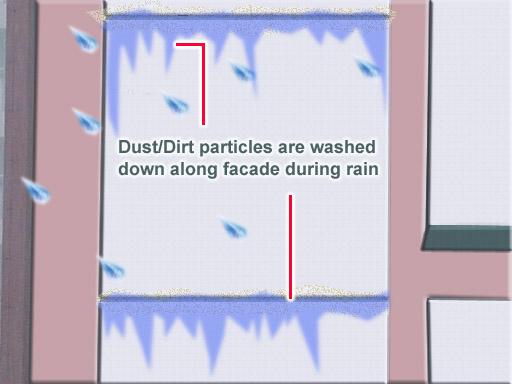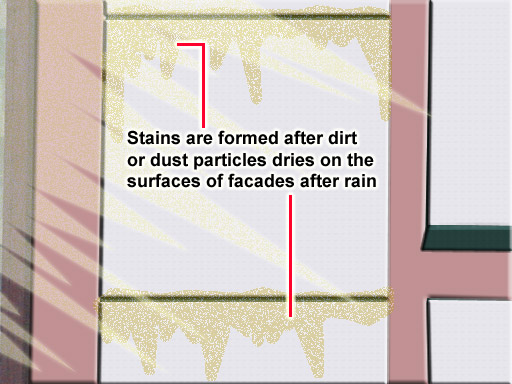Case 1
- Introduction
- Causes of Defects
- Good Practices
- Standards
- Maintenance and Diagnostics
- Remedial
- Similar Cases
- References
Cause of Defects



Obvious stains on the precast panel facades can be seen even from far. Dirt stains are usually caused in the following manner.
1. Dirt and infiltrants exists in the air around us, further deteriorated by the cars exhaust and movement which stirs up dirt from the roads near the building.
2. The dirt in the air can easily be accumulated in the expansion joints or grooves found in between most precast facade panels, especially when there is moisture in the grooves.
3. When it rains, the dirt will be washed out of the places and the dirt will sometimes get trapped on the surface and most will get washed down the building via the surface slowly. Dampness allows the atmospheric dust to adhere where it does not adhere so well to adjacent dryer areas.
4. When the rain stops and the sun dries the facades, the dirt that got trapped on the surface will be dried and that will form dirt streaks on the facades of the building, especially near the crevices and parapets areas.
The following table gives typical examples of atmospheric pollutants.
| Pollutants | Examples | Sizes | Sources | Possible effects |
| Aerosols | Sulphur dioxide (SO2) | Gaseous | Burning of fuels | Formation of acid rain. Reaction with water and other materials to form sulphates and chlorides to cause destruction to façade materials. |
| Soot or black smoke | Smoke from tobacco, coal, fuel oil, metallurgical industry | <1 pm | Imperfect combustion | Transported by air and deposited on facades to cause stains |
| Coarse particulate matter | Ash, dust, rock debris, mineral dust. | >1 pm | Unburnt fuel and dust from roads and industries | Transported by air for short distances and deposited more easily on horizontal or sloping surfaces to form stains. |
Table 1: Atmospheric pollutants
5. The following factors can determine the degree of staining:
- The pollution content of the air where the building is resided;
- The flow pattern of rainwater over building façade;
- The quality of the materials used and workmanship on the façade; and
- The facade’s design features.
Environmental factors are beyond the control of the designers. However, the degree of staining can be mitigated by controlling the pollution and understanding weather conditions.


See also Staining of Facades
Staining on a facade has a lot to do with the pattern of rainwater runoff, which in turn is dependent on the facade configuration, colour, texture, as well as the “roughness” and “water absorption” properties of the materials used:

